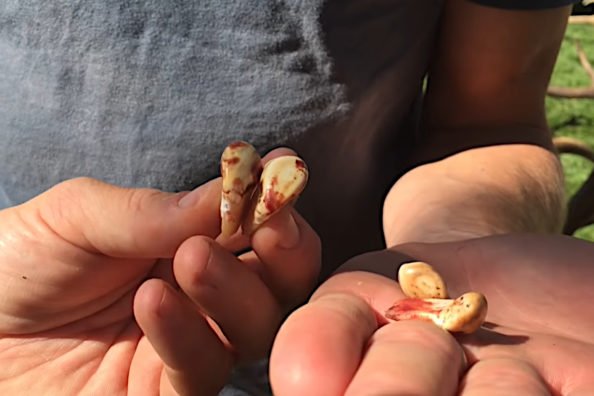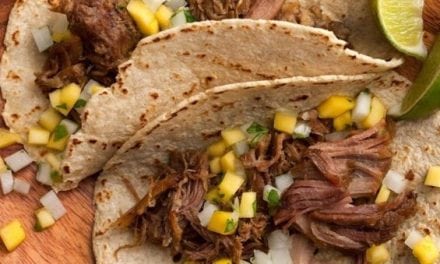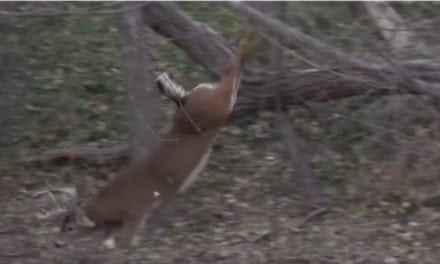
Everything you need to know about elk ivories.
Have you ever heard of elk ivory? If you haven’t, you probably aren’t alone. Not a ton of people know that modern elk in North America are carrying around a remnant of the past from their prehistoric ancestors.
These “ivories” are teeth, and they’re easy to miss if you don’t know where to look.
We’ll go over what they are, how to remove them and why you should hold onto them.
What are elk ivories?
When you hear the word “ivory,” you’re likely thinking of the tusks of an elephant or the teeth of a walrus, whale or hippo. Well, elk ivory is that authentic kind of ivory. Hundreds of thousands of years ago, the ancestors of modern elk are believed to have probably had full-fledged tusks. This isn’t unheard of in the greater deer family. Just look at the Muntjac deer, a species native to Asia. This species still has upper canine tusks.
The bucks use these tusks to fight and establish social order. It is very likely the ancestors of modern elk had similar tusks that were used for the same purpose once upon a time. However, as time has passed, nature changed the design of Wapiti or Rocky Mountain elk. Antlers took the place of tusks and these upper canine teeth became worthless. So, they started to disappear.
Today, most people don’t even realize they are there because the pair of ivories is hidden in the elk’s upper jaw. You may also hear these upper front teeth referred to as “eye teeth,” “whistlers,” or “buglers.” People have come up with all sorts of creative names for them over the years, but all these names are talking about the same thing.
And yes, these ivory teeth are just that, real ivory. And they’re present in both bull elk and cow elk. Just like other elk teeth, they can slowly get worn down and stained over time as the elk gets older.
How much are elk ivories worth?
This is a very common question and has been for hundreds of years. Native Americans were some of the first to use elk ivories as currency. Today they are prized by jewelers and crafts enthusiasts. One of the most popular uses for them is to make elk ivory jewelry.
But when it comes to putting a dollar value on an elk tooth, it can get complicated. It doesn’t appear the value is significantly high today. There are lots of the stuff on sale on eBay for “Buy it Now” prices around $30-40 a pair here in the United States. I noted several lots of unmatched ivories that only had a few hours of bidding left. The prices were anywhere from $10-46 at the most. A lot probably depends on condition, size and color.
Any sort of ivory is bound to have some value. But it’s not like elk are an uncommon animal in North America. So, we’re guessing these prices are probably close to what you could get. That’s not bad for a set of tiny, prehistoric tusks, but it’s not a fortune either.
Keep in mind that some states heavily regulate which parts of an animal you can sell and which ones you cannot. We’d advise you to check your local game regulations before you try to sell the canines from that big archery bull you shot last fall. Better safe than sorry.
For the most part it seems adornment with fine jewelry is the most common use of elk ivory. It may not hold a lot of monetary value, but some of the pieces I saw did look quite nice. An elk ivory ring or set of earrings would make for a great memento of the hunt.
How to remove elk ivories
Here is the tricky part. Many hunters down their elk in extremely remote areas of the North American wilderness. Your first and only thought may be packing your animal out of the woods. Especially if you’re in a heavily wooded and high terrain state like Colorado. It’s easy to forget about those two special teeth hidden in the upper jaw.
Most hunters agree, getting the ivories out is no easy feat. They’re dug in well and it takes a lot of cutting with a knife to get them free. I noticed that many jewelers have put wording on their website advising hunters to NOT use pliers when trying to get the ivories free. We get it, it’s tempting to want to do so, and probably easier. But you could end up scratching or otherwise damaging the ivories and then they have no value to anyone other than yourself.
But we found that one of our favorite hunting YouTube channels, Hushin, demonstrated another way to extract this yellow gold without a lot of fuss and muss. Just watch the video above where Eric uses a block and a hammer to quickly extract the ivories from the jaw of a bull he shot a few days prior. It looks like the head has dried out a bit, which should have made the task more difficult, but he easily gets those ivories out.
Eric says an old hunter taught him the trick. It seems like there is almost always a better way to do things found by an old timer, isn’t there? He simply uses a hammer and block of wood to quickly pop the ivories out of the jaw. We’d recommend using this technique if you have a block and hammer handy. It might be a good idea to throw these items in the back of your truck before your first elk hunt of the year.
Why you should keep your elk ivories
Even if it appears that elk ivories don’t have a lot of monetary value right now, that doesn’t mean it will always be true. If you’re the kind of lucky hunter who gets to bag an elk every year, put those elk teeth away and save them for a rainy day. Who knows what they’ll be worth in the future?
If you’re good with crafts, this is a good chance to make a gift for someone special that comes from the heart. Maybe your significant other “tolerates” your hunting obsession. A handmade elk ivory pendant or piece of jewelry would be a good way to say thank you.
You could also use them to form lasting memories. Did your child just shoot his or her first elk? Make them a pendant to wear around their neck. You could even make matching ones, one for you and one for them. They’re sure to hold a lot of sentimental value as your child grows older.
But perhaps the best reason to hang onto elk ivory is to simply utilize as much of the animal as you can. As hunters, we owe it to the animal to let very little go to waste. Even if you can’t see a use for the ivory right now, hang onto them. You just may find the perfect use in the future.
For more outdoor content from Travis Smola, be sure to follow him on Twitter and check out his Geocaching and Outdoors with Travis YouTube channels.
NEXT: EVERYTHING THERE IS TO FIGURE OUT ABOUT COLORADO ELK HUNTING
WATCH:
The post Elk Ivories: What They Are, How to Extract Them, and Why You Should Keep Them appeared first on Wide Open Spaces.















